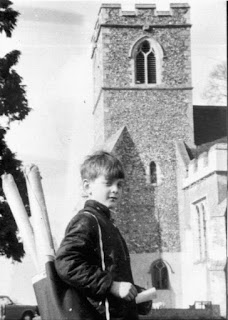English
Brasses
The proper name is ‘Monumental Brass;’ they’re also found
in profusion in Belgium. We thought the English ones were far prettier – more artistic.
The taking of rubbings of these objects by tourists was all the rage in the 60’s
when we moved to England; today much less so. ‘Rubbing’ consisted of taping a
piece of high quality paper over the brass and then carefully but somewhat
vigorously rubbing the surface with a hard wax bar. These bars were a type of
warehouse crayon which at about that time was being specially manufactured for
the purpose of providing the amateur enthusiasts with exactly the right colors
and consistency for the activity. In
those good old days one could make appointments at the little country churches
or just show up at the many cathedrals that had these objects either inset in
the stone floors or on the walls. The practice today has waned somewhat. There
was and probably still is a society devoted to the study and publication of
information on these fascinating and very durable objects. We belonged to the
Society and at one time had a significant collection of their pamphlets and
books as well as a collection of about 50 rubbings we had managed to make while
living there. We did make a special
summer visit to England in the 70’s to attend a week long meeting of the
Society held at a large estate home near Windsor. This grand house was used as
a girl’s school during the year and was available for conferences in the summer.
The Village of Stoke D’Abernon in Surrey predates
the Norman Conquest. In fact the village church is on private land and is said
to be partially constructed from the bricks of the Roman farmhouse that once
stood there. Buried in this charming little church is John D’Abernoun The Elder
who died in about 1277. His gorgeous memorial brass is said to be the oldest in
England and is certainly, in our opinion, the most beautiful. Barbara sent a post
card to the vicar and requested a Saturday appointment for us to rub the famous
brass. This was granted and this rubbing hung in our living room until the
summer of 2016. In the interest of preservation brasses of this sort are no
longer available to rub. There may be replicas in brass centers in London but
most of the original brasses are off limits these days.

A special wax was produced to do his shield – a brilliant
cobalt blue.
Below is son Patrick, age six, ready to assist.
Below is son Patrick, age six, ready to assist.
The story of Robert D’Bures of Acton, Suffolk has a
bit more action and is a bit more interesting. Again we made arrangements by
postcard to visit the church on a Saturday. Acton is about 80 miles East of
London and is more or less in the center of East Anglia, beautiful country by
the way. We three in our little Rootes Husky shooting brake were no load. This
vehicle could comfortably seat four. But its utility was soon to be tested.
The vicar greeted us enthusiastically when we arrived
and asked if we could do him a tiny favor before we began our task. We of
course had no choice but to joyfully agree. They had just concluded a meeting
of a sizeable group of the ‘old dears’ as they are called in England (female
senior citizens). Would we please give a hand and take them around to their
homes for him. So two or three at a time we wandered about the countryside
finding the cottages to which each belonged. The task finished we reported back
and he asked if we would like some lunch. We agreed and he said it was necessary
to let the pub know what we wanted so they could prepare it (Ham sandwiches and
a half pint of Adman’s). The pub still stands –
After lunch we reported to the church –
The D’Bures family has a long and famous history in
these parts. Robert died in 1337 after long and faithful service to Edward I.
We had a plastic replica of this brass belonging to
All Souls Episcopal Church in San Diego hanging for many years on the other
side of our fireplace. Both of these depictions are life size.






No comments:
Post a Comment